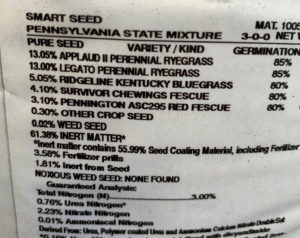How Much Grass Seed Are You Really Getting?
August 24th, 2021
You might assume that a bag of grass seed contains all or mostly grass seed, but if you pay attention to the labels, you’ll find that’s usually not the case these days.

Read those grass-seed labels. You might be surprised what’s in the bag.
Many bags of retail grass seed contain only half grass seed with the rest made up of fertilizer, coatings, fillers, and other “inert” materials. Some lawn-patching products even contain up to 90 percent of non-seed ingredients, primarily paper.
It’s easy to tell how much actual grass seed you’re getting for your dollar. The Federal Seed Act, administered by the U.S. Department of Agriculture, requires grass-seed bags to spell out the amounts and varieties of each grass seed inside as well as the percentage of the bag’s weight that’s devoted to non-seed materials.
Although the format can vary, seed companies must label their bags with several standard pieces of information.
These include germination rates, where the seed originated, when the seeds were tested, when they should be sold by, and the percentage of weed seeds.
Two of the most important categories are the makeup of the grass seed and what else is in the bag.
Federal label laws require companies to list the percentage, by weight, of each of the specific grass-seed varieties in the bag. By adding these together, you can tell what percentage of the bag’s total weight is actual grass seed.
Bags then must list percentages of other ingredients, which can include coatings (typically fertilizer), weed seeds, and “inert matter.”
Inert matter is a catch-all term for anything else that doesn’t grow. It includes unavoidable left-overs from the seed-cleaning process, such as chaff, broken seeds, and seed stems, but it also can include added fillers or mulching materials, such as sawdust or paper.
When companies don’t add fillers, percentages of other materials typically add up to less than 2 percent of the bag’s weight.
Read the labels, though, and you’ll find the percentages of coatings and inert matter add up to 50 percent or more on many of them.
To accurately compare seed prices brand to brand, multiply the listed percentage of grass seed by the bag’s total weight to determine how many pounds of actual grass seed you’re getting.
Then divide the bag’s price by the total pounds to get a per-pound price.
For example, a 20-pound bag that’s only 50 percent seed has 10 pounds of seed (20 multiplied by .5).
A bag of that selling for $70 has a per-pound seed cost of $7 ($70 divided by 10 pounds).
On the other hand, a 20-pound bag selling for $85 that’s 98 percent seed works out to $4.34 per pound (20 multiplied by .98 equals 19.8 pounds of actual seed, then $85 divided by 19.8 equals $4.34).
Although the former sounds cheaper when you compare bag-to-bag prices, the second one actually delivers far more seed for the dollar.
There’s nothing wrong with adding coatings or mulch materials to grass-seed bags. Maybe you like the idea of all-in-one products.
Just be aware that you might be paying mostly for paper when you think you’re getting mostly grass.







